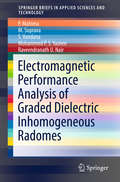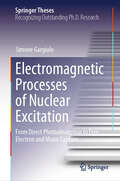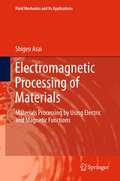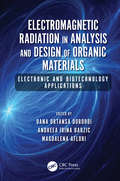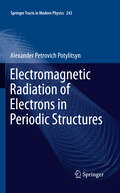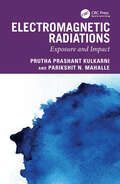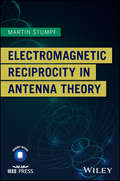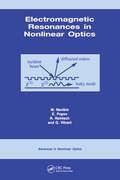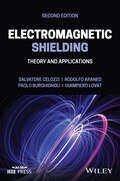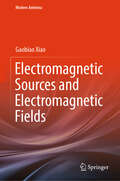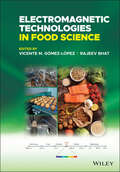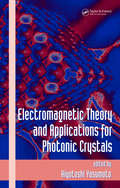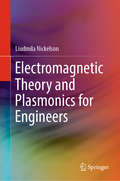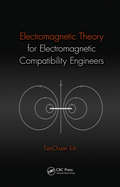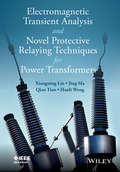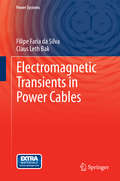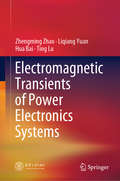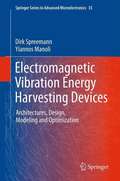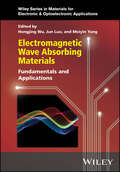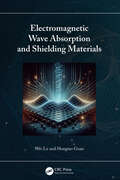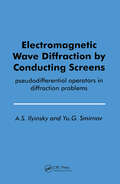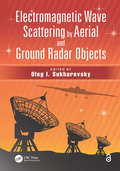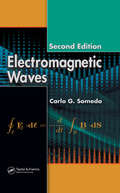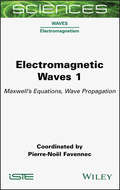- Table View
- List View
Electromagnetic Performance Analysis of Graded Dielectric Inhomogeneous Radomes (SpringerBriefs in Applied Sciences and Technology)
by Raveendranath U. Nair P. Mahima M. Suprava S. Vandana Mohammed P.S. YazeenThis book reports on a new radome wall configuration based on an inhomogeneous planar layer, which overcomes current fabrication constraints in radome design and yields improved electromagnetic (EM) characteristics. The book also includes a detailed description of radomes and antenna-radome interaction studies for different radome wall configurations. The radome wall was designed using the equivalent transmission line method (EQTLM), since it requires less computational speed and provides accurate results. In order to substantiate the accuracy of the results obtained using EQTLM, the simulated results based on full wave methods like CST Microwave Studio Suite are also included. The EM performance analysis of the antenna-radome system for two radome shapes, tangent ogive (for airborne applications) and hemispherical (for ground-based applications), was performed using Geometric Optics Method in conjunction with the Aperture Integration Method. To show the efficacy of the new design, a comparison of performance characteristics between the novel radome and conventional wall configurations is also included. Lastly, it presents antenna-radome interaction studies for various aperture distributions. The book offers a unique resource for all researchers working in the area of microwave radomes.
Electromagnetic Processes of Nuclear Excitation: From Direct Photoabsorption to Free Electron and Muon Capture (Springer Theses)
by Simone GargiuloFor decades, scientists have envisioned the possibility of storing energy in the form of nuclear excitations, resulting in specific nuclear configurations known as isomers. These unique metastable states have the ability to maintain their excited state for periods that range from several years to time spans exceeding the age of the Universe. However, despite numerous research efforts, achieving effective and practical control over isomer activation or depletion continues to be an unresolved challenge. This book delves into the world of isomers, beginning with an accessible overview of their essential properties and significance as long-duration energy storage solutions. Across the chapters, the book delves into diverse electromagnetic mechanisms responsible for nuclear excitation. It presents the ongoing debate surrounding the Nuclear Excitation by Electron Capture (NEEC) process, offering a comprehensivehistorical background that ranges from its early proposal to the latest tools employed for its investigation. The subsequent chapter explores the possibilities of using muons, introducing a novel process called Nuclear Excitation by Free Muon Capture (NEμC). The primary aim of these sections is to identify methods that could either increase the likelihood of these nuclear processes or provide real-time external manipulation over them. In the last chapter, the book revisits the process of nuclear photoabsorption in optical laser-generated plasma through experimental efforts, offering a fresh interpretation of existing literature results. Overall, the book delivers a clear and comprehensive overview, aiming to assist newcomers and established scientists in quickly grasping the core aspects of the subjects, possibly guiding their research endeavors. Hopefully, this resource will act as a catalyst for sparking new ideas while providing insights into the intricacies and opportunitiespresented by nuclear excitations within the realm of nuclear physics.
Electromagnetic Processing of Materials
by Shigeo AsaiThis book is both a course book and a monograph. In fact, it has developed from notes given to graduate course students on materials processing in the years 1989 to 2006. Electromagnetic Processing of Materials (EPM), originates from a branch of materials science and engineering developed in the 1980s as a field aiming to create new materials and/or design processes by making use of various functions which appear when applying the electric and magnetic fields to materials. It is based on transport phenomena, materials processing and magnetohydrodynamics. The first chapter briefly introduces the history, background and technology of EPM. In the second chapter, the concept of transport phenomena is concisely introduced and in the third chapter the essential part of magnetohydrodynamics is transcribed and readers are shown that the concept of transport phenomena does not only apply to heat, mass and momentum, but also magnetic field. The fourth chapter describes electromagnetic processing of electrically conductive materials such as electromagnetic levitation, mixing, brake, and etc., which are caused by the Lorentz force. The fifth chapter treats magnetic processing of organic and non-organic materials such as magnetic levitation, crystal orientation, structural alignment and etc., which are induced by the magnetization force. This part is a new academic field named Magneto-Science, which focuses on the development of super-conducting magnets. This book is written so as to be understood by any graduate student in engineering courses but also to be of interest to engineers and researchers in industries.
Electromagnetic Radiation in Analysis and Design of Organic Materials: Electronic and Biotechnology Applications
by Andreea Irina Barzic Dana Ortansa Dorohoi Magdalena AfloriBridging condensed matter physics, photochemistry, photophysics, and materials science, Electromagnetic Radiation in Analysis and Design of Organic Materials: Electronic and Biotechnology Applications covers physical properties of materials in the presence of radiation from across the electromagnetic spectrum. It describes the optical, spectral, thermal, and morphological properties of a wide range of materials and their practical implications in electronic and biotechnologies. It discusses recent advances in the use of radiation in analysis of materials and design for advanced applications. The book contains experimental and theoretical issues that reflect the impact of radiation on materials characteristics highlighting their ease of analysis or adaptation for applications as optical filters, drug delivery systems, antimicrobial layers, amphetamine detectors, or liquid crystal displays.
Electromagnetic Radiation of Electrons in Periodic Structures
by Alexander PotylitsynPeriodic magnetic structures (undulators) are widely used in accelerators to generate monochromatic undulator radiation (UR) in the range from far infrared to the hard X-ray region. Another periodic crystalline structure is used to produce quasimonochromatic polarized photon beams via the coherent bremsstrahlung mechanism (CBS). Due to such characteristics as monochromaticity, polarization and adjustability, these types of radiation is of large interest for applied and basic research of accelerator-emitted radiation. The book provides a detailed overview of the fundamental principles behind electromagnetic radiation emitted from accelerated charged particles (e.g. UR, CBS, radiation of fast electrons in Laser flash fields) as well as a unified description of relatively new radiation mechanisms which attracted great interest in recent years. This are the so-called polarization radiation excited by the Coulomb field of incident particles in periodic structures, parametric X-rays, resonant transition radiation and the Smith-Purcell effect. Characteristics of such radiation sources and perspectives of their usage are discussed. The recent experimental results as well as their interpretation are presented.
Electromagnetic Radiations: Exposure and Impact
by Prutha Prashant Kulkarni Parikshit N.MahalleThe book delivers an understanding of emission theory and its effects on different strata of life. It contains seven chapters including probable remedial measures and solutions to increase reduced radiation life expectancy. The text explains important topics such as the compatibility of the human body and wireless communication, applications and effectiveness of radiating power, energy harvesting, green energy solutions, and the human nervous system.This book: Discusses topics related to radiation and electromagnetic emissions, including their sources, effects, and ways to reduce exposure. Covers various aspects of the impact of electromagnetic fields on health and the environment, including measurement and modeling techniques, exposure assessment, and health effects. Explains electromagnetic emissions and their applications, as well as the impact of radiation on living organisms, including flora, fauna, and human beings. Provides a detailed analysis of the effects of radiation on animal and plant life. Highlights the potential benefits of electromagnetic emissions and provides information on how to mitigate the negative effects of radiation. It is primarily written for senior undergraduate, graduate students, and academic researchers in the fields including electrical engineering, electronics, communications engineering, and physics.
Electromagnetic Reciprocity in Antenna Theory
by Martin StumpfProvides a self-contained account on applications of electromagnetic reciprocity theorems to multiport antenna systems The reciprocity theorem is among the most intriguing concepts in wave field theory and has become an integral part of almost all standard textbooks on electromagnetic (EM) theory. This book makes use of the theorem to quantitatively describe EM interactions concerning general multiport antenna systems. It covers a general reciprocity-based description of antenna systems, their EM scattering properties, and further related aspects. Beginning with an introduction to the subject, Electromagnetic Reciprocity in Antenna Theory provides readers first with the basic prerequisites before offering coverage of the equivalent multiport circuit antenna representations, EM coupling between multiport antenna systems and their EM interactions with scatterers, accompanied with the corresponding EM compensation theorems. In addition, the text: Presents basic prerequisites including the definition of the notation, integral transformations, and EM reciprocity theorems in their general form Explores multiport antenna forward-scattering theorem, multiport antenna matching theorem and uniqueness theorem Supplements each chapter with a solved illustrative example Electromagnetic Reciprocity in Antenna Theory is an excellent text for EMC and antenna researchers and students of the subject as well.
Electromagnetic Resonances in Nonlinear Optics (Advances in Nonlinear Optics)
by Michel Neviere R. Reinisch E. Popov G. VitrantThis book is devoted to the numerous phenomena arising from the interplay between electromagnetic resonances and nonlinear optical interactions. These resonances are associated with surface plasmas or guided waves, excited in nonlinear optical resonators such as prisms or grating couplers. Topics include rigorous theories of diffraction by gratings
Electromagnetic Shielding: Theory and Applications (Wiley Series in Microwave and Optical Engineering #192)
by Salvatore Celozzi Rodolfo Araneo Giampiero Lovat Paolo BurghignoliComprehensive Resource for Understanding Electromagnetic Shielding Concepts and Recent Developments in the Field This book describes the fundamental, theoretical, and practical aspects to approach electromagnetic shielding with a problem-solving mind, either at a design stage or in the context of an issue-fixing analysis of an existing configuration. It examines the main shielding mechanisms and how to analyze any shielding configuration, taking into account all the involved aspects. A detailed discussion on the possible choices of parameters suitable to ascertain the performance of a given shielding structure is also presented by considering either a continuous wave EM field source or a transient one. To aid in reader comprehension, both a theoretical and a practical engineering point of view are presented with several examples and applications included at the end of main chapters. Sample topics discussed in the book include: Concepts in transient shielding including performance parameters and canonical configurations Time domain performance of shielding structures, thin shields, and overall performance of shielding enclosures (cavities) How to install adequate barriers around the most sensitive components/systems to reduce or eliminate interference Details on solving core fundamental issues for electronic and telecommunications systems via electromagnetic shieldingFor industrial researchers, telecommunications/electrical engineers, and academics studying the design of EM shielding structures, this book serves as an important resource for understanding both the logistics and practical applications of electromagnetic shielding. It also includes all recent developments in the field to help professionals stay ahead of the curve in their respective disciplines.
Electromagnetic Sources and Electromagnetic Fields (Modern Antenna)
by Gaobiao XiaoThis book presents a modified spherical harmonic expansion method in which the electromagnetic fields and their sources are expanded with the same set of spherical vector basis functions in a similar procedure. Explicit expressions for the electromagnetic fields, potentials, energies, and the related Green’s functions are derived for the spherical modes in both frequency domain and time domain. Based on the formulation, the relationships between the electromagnetic sources, the electromagnetic far fields, and the electromagnetic near fields are clearly revealed. In particular, a nonuniform transmission line model is developed for intuitively characterizing the total radiation process. The introduction of the cutoff radius and the cutoff mode degree provides a simple reference for determining the numbers of degrees of freedom of the fields associated with sources in a bounded region. Based on the theory, an efficient hybrid method for synthesizing antenna arrays with complex footprints is proposed and demonstrated with several numerical examples. Effective algorithms are also developed for reconstructing the radiating part of the current sources.This book is intended for researchers, engineers, and graduate students who are interested in studying the energy transfer in electromagnetic radiation, synthesis and measurement of antenna arrays, and applications of inverse electromagnetic source problems.
Electromagnetic Technologies in Food Science
by Rajeev Bhat Vicente M. Gómez‐LópezA comprehensive source of in-depth information provided on existing and emerging food technologies based on the electromagnetic spectrum Electromagnetic Technologies in Food Science examines various methods employed in food applications that are based on the entire electromagnetic (EM) spectrum. Focusing on recent advances and challenges in food science and technology, this is an up-to-date volume that features vital contributions coming from an international panel of experts who have shared both fundamental and advanced knowledge of information on the dosimetry methods, and on potential applications of gamma irradiation, electron beams, X-rays, radio and microwaves, ultraviolet, visible, pulsed light, and more. Organized into four parts, the text begins with an accessible overview of the physics of the electromagnetic spectrum, followed by discussion on the application of the EM spectrum to non-thermal food processing. The physics of infrared radiation, microwaves, and other advanced heating methods are then deliberated in detail—supported by case studies and examples that illustrate a range of both current and potential applications of EM-based methods. The concluding section of the book describes analytical techniques adopted for quality control, such as hyperspectral imaging, infrared and Raman spectroscopy. This authoritative book resource: Covers advanced theoretical knowledge and practical applications on the use of EM spectrum as novel methods in food processing technology Discusses the latest progress in developing quality control methods, thus enabling the control of continuous fast-speed processes Explores future challenges and benefits of employing electromagnetic spectrum in food technology applications Addresses emerging processing technologies related to improving safety, preservation, and overall quality of various food commodities Electromagnetic Technologies in Food Science is an essential reading material for undergraduate and graduate students, researchers, academics, and agri-food professionals working in the area of food preservation, novel food processing techniques and sustainable food production.
Electromagnetic Theory and Applications for Photonic Crystals (Optical Science and Engineering)
by Kiyotoshi YasumotoPhotonic technology promises much faster computing, massive parallel processing, and an evolutionary step in the digital age. The search continues for devices that will enable this paradigm, and these devices will be based on photonic crystals. Modeling is a key process in developing crystals with the desired characteristics and performance, and Electromagnetic Theory and Applications for Photonic Crystals provides the electromagnetic-theoretical models that can be effectively applied to modeling photonic crystals and related optical devices.The book supplies eight self-contained chapters that detail various analytical, numerical, and computational approaches to the modeling of scattering and guiding problems. For each model, the chapter begins with a brief introduction, detailed formulations of periodic structures and photonic crystals, and practical applications to photonic crystal devices. Expert contributors discuss the scattering matrix method, multipole theory of scattering and propagation, model of layered periodic arrays for photonic crystals, the multiple multipole program, the mode-matching method for periodic metallic structures, the method of lines, the finite-difference frequency-domain technique, and the finite-difference time-domain technique.Based on original research and application efforts, Electromagnetic Theory and Applications for Photonic Crystals supplies a broad array of practical tools for analyzing and designing devices that will form the basis for a new age in computing.
Electromagnetic Theory and Plasmonics for Engineers
by Liudmila NickelsonThis book presents the theory of electromagnetic (EM) waves for upper undergraduate, graduate and PhD-level students in engineering. It focuses on physics and microwave theory based on Maxwell’s equations and the boundary conditions important for studying the operation of waveguides and resonators in a wide frequency range, namely, from approx. 10**9 to 10**16 hertz. The author also highlights various current topics in EM field theory, such as plasmonic (comprising a noble metal) waveguides and analyses of attenuations by filled waveguide dielectrics or semiconductors and also by conducting waveguide walls. Featuring a wide variety of illustrations, the book presents the calculated and schematic distributions of EM fields and currents in waveguides and resonators. Further, test questions are presented at the end of each chapter.
Electromagnetic Theory for Electromagnetic Compatibility Engineers
by Tze-Chuen TohEngineers and scientists who develop and install electronic devices and circuits need to have a solid understanding of electromagnetic theory and the electromagnetic behavior of devices and circuits. In particular, they must be well-versed in electromagnetic compatibility, which minimizes and controls the side effects of interconnected electric dev
Electromagnetic Transient Analysis and Novel Protective Relaying Techniques for Power Transformers (Wiley - IEEE)
by Qing Tian Jing Ma Xiangning Lin Hanli WengAn advanced level examination of the latest developments in power transformer protection This book addresses the technical challenges of transformer malfunction analysis as well as protection. One of the current research directions is the malfunction mechanism analysis due to nonlinearity of transformer core and comprehensive countermeasures on improving the performance of transformer differential protection. Here, the authors summarize their research outcomes and present a set of recent research advances in the electromagnetic transient analysis, the application on power transformer protections, and present a more systematic investigation and review in this field. This research area is still progressing, especially with the fast development of Smart Grid. This book is an important addition to the literature and will enhance significant advancement in research. It is a good reference book for researchers in power transformer protection research and a good text book for graduate and undergraduate students in electrical engineering. Chapter headings include: Transformer differential protection principle and existing problem analysis; Malfunction mechanism analysis due to nonlinearity of transformer core; Novel analysis tools on operating characteristics of Transformer differential protection; Novel magnetizing inrush identification schemes; Comprehensive countermeasures on improving the performance of transformer differential protection An advanced level examination of the latest developments in power transformer protection Presents a new and systematic view of power transformer protection, enabling readers to design new models and consider fresher design approaches Offers a set of approaches to optimize the power system from a microeconomic point of view
Electromagnetic Transients in Power Cables
by Filipe Faria da Silva Claus Leth BakFrom the more basic concepts to the most advanced ones where long and laborious simulation models are required, Electromagnetic Transients in Power Cables provides a thorough insight into the study of electromagnetic transients and underground power cables. Explanations and demonstrations of different electromagnetic transient phenomena are provided, from simple lumped-parameter circuits to complex cable-based high voltage networks, as well as instructions on how to model the cables. Supported throughout by illustrations, circuit diagrams and simulation results, each chapter contains exercises, solutions and examples in order to develop a practical understanding of the topics. Harmonic analysis of cable-based networks and instructions on how to accurately model a cable-based network are also covered, including several "tricks" and workarounds to help less experienced engineers perform simulations and analyses more efficiently. Electromagnetic Transients in Power Cables is an invaluable resource for students and engineers new to the field, but also as a point of reference for more experienced industry professionals.
Electromagnetic Transients of Power Electronics Systems
by Hua Bai Zhengming Zhao Liqiang Yuan Ting LuThis book discusses topics related to power electronics, especially electromagnetic transient analysis and control of high-power electronics conversion. It focuses on the re-evaluation of power electronics, transient analysis and modeling, device-based system-safe operating area, and energy balance-based control methods, and presenting, for the first time, numerous experimental results for the transient process of various real-world converters.The book systematically presents both theoretical analysis and practical applications. The first chapter discusses the structure and attributes of power electronics systems, highlighting the analysis and synthesis, while the second chapter explores the transient process and modeling for power electronics systems. The transient features of power devices at switching-on/off, transient conversion circuit with stray parameters and device-based system-safe operating area are described in the subsequent three chapters. The book also examines the measurement of transient processes, electromagnetic pulses and their series, as well as high-performance, closed-loop control, and expounds the basic principles and method of the energy-balanced control strategy. Lastly, it introduces the applications of transient analysis of typical power electronics systems.The book is valuable as a textbook for college students, and as a reference resource for electrical engineers as well as anyone working in the field of high-power electronics system.
Electromagnetic Vibration Energy Harvesting Devices
by Dirk Spreemann Yiannos ManoliElectromagnetic vibration transducers are seen as an effective way of harvesting ambient energy for the supply of sensor monitoring systems. Different electromagnetic coupling architectures have been employed but no comprehensive comparison with respect to their output performance has been carried out up to now. Electromagnetic Vibration Energy Harvesting Devices introduces an optimization approach which is applied to determine optimal dimensions of the components (magnet, coil and back iron). Eight different commonly applied coupling architectures are investigated. The results show that correct dimensions are of great significance for maximizing the efficiency of the energy conversion. A comparison yields the architectures with the best output performance capability which should be preferably employed in applications. A prototype development is used to demonstrate how the optimization calculations can be integrated into the design-flow. Electromagnetic Vibration Energy Harvesting Devices targets the designer of electromagnetic vibration transducers who wishes to have a greater in-depth understanding for maximizing the output performance.
Electromagnetic Vibration Energy Harvesting Devices: Architectures, Design, Modeling and Optimization (Springer Series in Advanced Microelectronics #35)
by Dirk Spreemann Yiannos ManoliElectromagnetic vibration transducers are seen as an effective way of harvesting ambient energy for the supply of sensor monitoring systems. Different electromagnetic coupling architectures have been employed but no comprehensive comparison with respect to their output performance has been carried out up to now. Electromagnetic Vibration Energy Harvesting Devices introduces an optimization approach which is applied to determine optimal dimensions of the components (magnet, coil and back iron). Eight different commonly applied coupling architectures are investigated. The results show that correct dimensions are of great significance for maximizing the efficiency of the energy conversion. A comparison yields the architectures with the best output performance capability which should be preferably employed in applications. A prototype development is used to demonstrate how the optimization calculations can be integrated into the design–flow. Electromagnetic Vibration Energy Harvesting Devices targets the designer of electromagnetic vibration transducers who wishes to have a greater in-depth understanding for maximizing the output performance.
Electromagnetic Wave Absorbing Materials: Fundamentals and Applications (Wiley Series in Materials for Electronic & Optoelectronic Applications)
by Hongjing WuElectromagnetic Wave Absorbing Materials Electromagnetic Wave Absorbing Materials presents information on the most promising electromagnetic wave absorbing materials, with timely coverage of both conventional and novel materials including 1D, 2D, and 3D materials. This book enables readers to address the growing specification needs in the field through optimizing electromagnetic parameters and promoting interface polarization, two key properties for wireless technology in electronic applications. Edited by three highly qualified academics with significant relevant research experience, Electromagnetic Wave Absorbing Materials includes discussions on: Materials including ferrites, graphene, carbon‐based composite absorbers, SiC ceramics, MOFs, and meta‐material based absorbers Recent advances in the field surrounding composite absorbers, conductive polymers, and ceramics, and other materials Potential improvements in the Internet of Things, 5G mobile applications, and intelligent transport systems through electromagnetic wave absorbing materials Potential improvements in the Internet of Things, 5G mobile applications, and intelligent transport systems through electromagnetic wave absorbing materials Applications including terrestrial and satellite communication (software radio, GPS, and satellite TV), environmental monitoring via satellite, and EMI shielding, as well as stealth applications Electromagnetic Wave Absorbing Materials is an essential reference on the subject for researchers and advanced students in the chemical, electronics, and communications industries, as well as R&D scientists at companies such as Apple, HUAWEI, and China Aerospace Science and Technology Corp (CASC).
Electromagnetic Wave Absorption and Shielding Materials
by Wei Lu Hongtao GuanThis book reveals the latest research findings and innovations in electromagnetic wave absorption and shielding by exploring the design and application of absorbent materials, the optimization of shielding structures and the improvement of testing and evaluation methods.From conductive materials to magnetic materials, and composite materials to nanomaterials, Electromagnetic Wave Absorption and Shielding Materials details the characteristics and advantages of various absorbent materials and explains their applications in electromagnetic wave absorption and shielding. It then introduces the different methods of electromagnetic shielding, including structural shielding and material shielding. The book also studies experimental and testing techniques, including measurement methods and evaluation criteria for electromagnetic wave absorption performance.The book will be of interest to researchers and graduate students in electromagnetic compatibility, materials science and engineering.
Electromagnetic Wave Diffraction by Conducting Screens pseudodifferential operators in diffraction problems
by Yu. G. SmirnovThis book covers the latest problems of modern mathematical methods for three-dimensional problems of diffraction by arbitrary conducting screens. This comprehensive study provides an introduction to methods of constructing generalized solutions, elements of potential theory, and other underlying mathematical tools. The problem settings, which turn out to be extremely effective, differ significantly from the known approaches and are based on the original concept of vector spaces 'produced' by Maxwell equations. The formalism of pseudodifferential operators enables to prove uniqueness theorems and the Fredholm property for all problems studied. Readers will gain essential insight into the state-of-the-art technique of investigating three-dimensional problems for closed and unclosed screens based on systems of pseudodifferential equations. A detailed treatment of the properties of their kernels, in particular degenerated, is included. Special attention is given to the study of smoothness of generalized solutions and properties of traces.
Electromagnetic Wave Scattering by Aerial and Ground Radar Objects
by Oleg I. SukharevskyElectromagnetic Wave Scattering by Aerial and Ground Radar Objects presents the theory, original calculation methods, and computational results of the scattering characteristics of different aerial and ground radar objects. This must-have book provides essential background for computing electromagnetic wave scattering in the presence of different kinds of irregularities, as well as Summarizes fundamental electromagnetic statements such as the Lorentz reciprocity theorem and the image principle Contains integral field representations enabling the study of scattering from various layered structures Describes scattering computation techniques for objects with surface fractures and radar-absorbent coatings Covers elimination of "terminator discontinuities" appearing in the method of physical optics in general bistatic cases Includes radar cross-section (RCS) statistics and high-range resolution profiles of assorted aircrafts, cruise missiles, and tanks Complete with radar backscattering diagrams, echo signal amplitude probability distributions, and other valuable reference material, Electromagnetic Wave Scattering by Aerial and Ground Radar Objects is ideal for scientists, engineers, and researchers of electromagnetic wave scattering, computational electrodynamics, and radar detection and recognition algorithms.
Electromagnetic Waves (Second Edition)
by Carlo G. SomedaAdapted from a successful and thoroughly field-tested Italian text, the first edition of Electromagnetic Waves was very well received. Its broad, integrated coverage of electromagnetic waves and their applications forms the cornerstone on which the author based this second edition. <P><P>Working from Maxwell's equations to applications in optical communications and photonics, Electromagnetic Waves, Second Edition forges a link between basic physics and real-life problems in wave propagation and radiation. <P><P>Accomplished researcher and educator Carlo G. Someda uses a modern approach to the subject. Unlike other books in the field, it surveys all major areas of electromagnetic waves in a single treatment. <P><P>The book begins with a detailed treatment of the mathematics of Maxwell's equations. It follows with a discussion of polarization, delves into propagation in various media, devotes four chapters to guided propagation, links the concepts to practical applications, and concludes with radiation, diffraction, coherence, and radiation statistics. <P><P>This edition features many new and reworked problems, updated references and suggestions for further reading, a completely revised appendix on Bessel functions, and new definitions such as antenna effective height. <P><P>Illustrating the concepts with examples in every chapter, Electromagnetic Waves, Second Edition is an ideal introduction for those new to the field as well as a convenient reference for seasoned professionals.
Electromagnetic Waves 1: Maxwell's Equations, Wave Propagation
by Pierre-Noël FavennecElectromagnetic Waves 1 examines Maxwell’s equations and wave propagation. It presents the scientific bases necessary for any application using electromagnetic fields, and analyzes Maxwell’s equations, their meaning and their resolution for various situations and material environments. These equations are essential for understanding electromagnetism and its derived fields, such as radioelectricity, photonics, geolocation, measurement, telecommunications, medical imaging and radio astronomy. This book also deals with the propagation of electromagnetic, radio and optical waves, and analyzes the complex factors that must be taken into account in order to understand the problems of propagation in a free and confined space. Electromagnetic Waves 1 is a collaborative work, completed only with the invaluable contributions of Ibrahima Sakho, Hervé Sizun and JeanPierre Blot, not to mention the editor, Pierre-Noël Favennec. Aimed at students and engineers, this book provides essential theoretical support for the design and deployment of wireless radio and optical communication systems.
